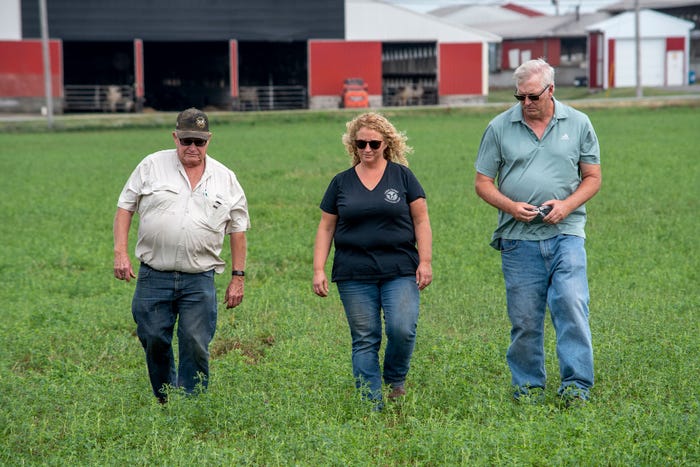October 12, 2023

The value of planting green is being demonstrated by farms participating in the Genesee River Demonstration Farms Network created by American Farmland Trust and conservation partners in New York’s Great Lakes watershed region.
Planting green involves seeding a cash crop — corn or soybeans — into a living cover crop. The cash crop can take advantage of nutrients fed into the soil by the cover crop, and by delaying cover crop termination, farmers can maximize the soil health benefits of cover crops while mitigating the challenges of wet spring soils. Cover crop residue also helps suppress weeds and soil erosion.
Table Rock Farm in Castile, N.Y., and Lamb Farms of Oakfield, N.Y., are AFT Genesee River Demonstration Farms Network participants that have seen the benefits of planting green.
Table Rock Farm plants corn silage and alfalfa, and grass for haylage on a three-year rotation. The crops are used in a total mixed ration for the farm’s 1,200-cow dairy herd. Co-owner and operator Meghan Hauser and the crops team, which includes crops specialist Jeffrey Jordan, consistently test and evaluate practices to enhance soil health to support quality crop production in a vertical and no-till system. Their cover crop plan includes winter rye and oats, radishes, and triticale.
“We sold our plow more than 20 years ago and have never looked back,” Hauser says. “We quickly saw benefits with increased earthworm activity and no more washouts after heavy rains.”

CHECKING FIELDS: Jim Veazey and Janette Veazey-Post of Lamb Farms check the fields with David DeGolyer of the Western New York Crop Management Association.
“Reduced tillage means less fuel expense,” Jordan says. “When planting green, the fields were drier and had more nitrogen available. We were able to get on the fields in a more timely way. This all contributed to high-quality corn production.”
At Lamb Farms, co-owner Janette Veazey-Post’s goal is to use environmentally friendly practices to raise high-quality feed for the farm’s 10,000-cow dairy herd.
“We first tried strip tilling,” she says. “Soil tilth improved, infiltration improved, allowing us to plant earlier. The time and labor saved was directed to cover cropping, manure injection, split applications of nitrogen and planting green.
“We started planting green on 350 acres in 2019, with corn seeded into a mix of triticale, oats and crimson clover. With GPS technology, we can precisely plant into a strip of just a few inches. Less tillage, particularly on our rolling hills, has reduced soil erosion and keeps nutrients in the field,” Veazey-Post adds. “We have also seen higher and more consistent crop yields.”
Collaboration and economics
“We conduct economic analysis as a step toward better understanding the cost-benefit ratio of good agricultural land management practices in the immediate and short term, as well as the impact on each farm’s business plan longer term,” explains Aaron Ristow, senior agricultural specialist at American Farmland Trust and director of the Demonstration Farm Network.
John Hancher, agricultural economist with Cornell Cooperative Extension’s Northwest New York Dairy, Livestock and Field Crops Team, partnered on the project using the Dairy Farm Business Summary.
Hauser selected 2001 as the tipping-point year, as it was when the farm began utilizing minimal to no-till practices. Over time, nutrient management, cover cropping and planting green were added.
“Analysis of the combined changes comparing the ‘before’ to ‘after’ soil health adoption at Table Rock showed a farm net income of $79 per acre over an 1,800-acre study area,” Ristow says. “Crop value, figured at price times yield, increased by an average of $111 per acre and yield was more consistent year-to-year. The overall return on investment in the soil health practices was 125%. The data show that Table Rock Farm was able to adopt soil health practices alongside other changes in field operations while improving economic performance.”

PLANTED GREEN: This is a green-planted field at Table Rock Farm. An analysis showed the overall return on investment in soil health practices at Table Rock Farm was close to 125%.
Similar analysis using Farm Credit East data was applied to Lamb Farms. Calculations showed that soil health practices, plus other changes in farm practices improved the farm’s economic performance with a 61% return on investment over 12,744 acres.
Hauser says participation in the AFT network and with Cornell Extension is important.
“It is inspiring to work side-by-side with scientists, educators and other ‘experimenters’ who are just as excited as we are to figure out new things,” she says. “The AFT team did vigorous research and then organized meetings to share the data and information with our neighbors.”
Award-winning farms
In 2021, Table Rock Farm received the New York Agricultural Environmental Management-Leopold Conservation Award that honors farmer efforts to protect the environment through preservation of soil and water quality.
Lamb Farms was named the 2021 New York Beef Council’s Environmental Stewardship Award winner and, a year later, the National Cattlemen’s Association regional environmental award winner.

CHECKING FORAGE: Jeffrey Jordan, crops specialist with Table Rock Farm, holds forage samples from the farm. Jordan says planting green has contributed to drier fields and more nitrogen available to crops, all contributing to high-quality corn production.
Funding from the New York Farm Viability Institute, the Great Lakes Restoration Initiative, and USDA Natural Resources Conservation Service supported this three-year AFT study. The funding was “critical to advancing the Demonstration Farm Network goals,” Ristow says.
To learn more about Lamb Farms and other New York farms participating in the Genesee River Demonstration Farms Network, visit farmland.org.
Dunn writes from her farm in Mannsville, N.Y.
About the Author(s)
You May Also Like




